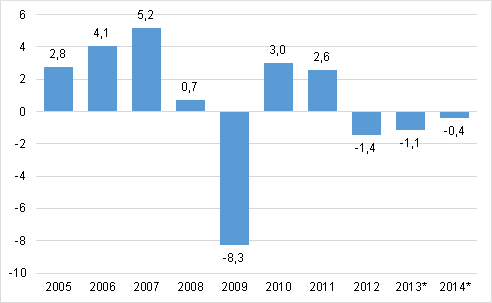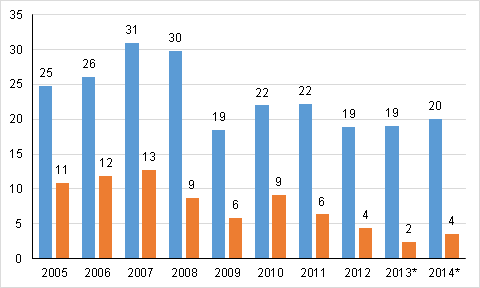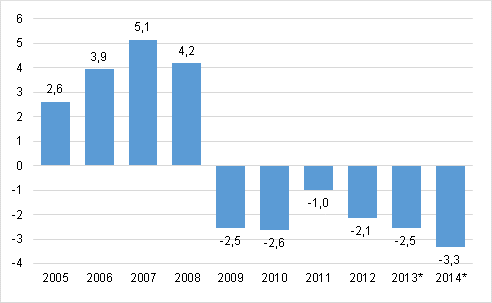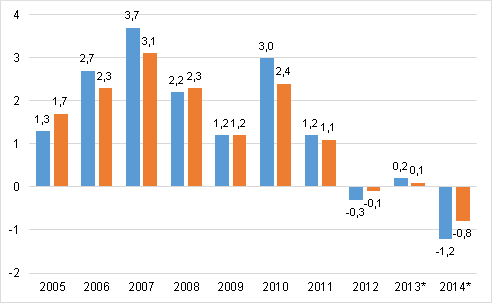1. Gross domestic product decreased by 0.4 per cent last year
According to Statistics Finland's revised preliminary data, the volume of Finland’s GDP contracted by 0.4 per cent in 2014. According to the initial preliminary data released in March, the decrease was 0.1 per cent. The GDP became revised as new data on intermediate consumption in various industries in particular became available.
In 2013, the volume of GDP contracted by 1.1 per cent whereas previous estimates put the decline at 1.3 per cent. Production contracted for the third year in a row last year and was at the 2006 level.
Figure 1. Annual change in the volume of gross domestic product, per cent

Gross domestic product, or the value added created in the production of goods and services, amounted to EUR 205 billion in 2014 at current prices. GDP per capita was EUR 37,600.
Households' adjusted disposable income describing their economic well-being declined by 0.8 per cent in real terms in 2014. In addition to net income, adjusted income also takes into consideration welfare services produced by the public sector and organisations for households, such as educational, health and social services.
1.1 Production contracted in most industries
The volume of value added decreased in most industries last year, such as in manufacturing, construction, transport, public administration, and health and social services. By contrast, the volume of value added increased, for example, in financial and insurance activities, computer and related services, manufacture of basic metals, and pharmaceutical preparations.
Viewed by current price, value added increased most in financial and insurance activities, computer and related services, the electronics industry, and pharmaceutical preparations. Value added decreased most in construction and trade.
1.2 Demand did not generate growth
Demand items in the national economy remained at previous year's level or declined. Only the volume of public consumption expenditure grew slightly by 0.3 per cent. Private consumption expenditure increased by 0.5 per cent but public consumption expenditure decreased by 0.2 per cent. The proportion of consumption expenditure to GDP grew to 80.2 per cent.
The volume of investments decreased by 3.3 per cent. Investments in building constructions and in research and development declined in particular. By contrast, investments in machinery and equipment, computer software and civil engineering grew a little. The investment rate or the proportion of investments of gross domestic product fell to 20.3 per cent.
The volume of exports shrunk by 0.7 per cent in 2014 and that of imports remained unchanged. The volume of goods exports and imports increased slightly but the imports and exports of services decreased clearly. The share of exports of gross domestic product decreased to 37.9 per cent and the share of imports to 38.7 per cent.
1.3 Work input decreased last year
According to the National Accounts, the number of employed persons declined by 21,000 last year. Jobs decreased most in manufacturing, construction and trade. Hours worked diminished by 27 million hours or 0.7 per cent.
The productivity of labour in the whole national economy, i.e. gross value added at constant prices divided by number of hours worked improved by 0.3 per cent last year.
1.4 Prices went up a little
The economy’s overall price level rose by 1.6 per cent last year as measured by the GDP price index.
The Consumer Price Index went up by 1.0 per cent, but the price index of household consumption expenditure in National Accounts by 1.7 per cent. In National Accounts, the prices of housing services are measured with changes in market rents, whereas the Consumer Price Index also takes into consideration the expenditure on owner-occupied housing. The methods used in National Accounts and in the Consumer Price Index for measuring development in the prices of insurance and financial intermediation services also deviate from each other.
The terms of trade improved by 0.8 per cent because import prices fell by slightly more than export prices.
1.5 National income also contracted by 0.4 per cent in real terms
Net national income grew by one per cent in nominal terms last year, and stood at EUR 30,400 per capita. Net national income went down by 0.4 per cent in real terms. Finland's gross national income amounted to EUR 205 billion last year. It was slightly smaller than the gross domestic product. The gross national income also diminished in real terms last year.
Households’ wage and salary income increased by 0.3 per cent and employers’ social insurance contributions declined by 0.2 per cent in 2014. In all, the share of compensation of employees of national income was 61.1 per cent. The respective proportion in the previous year was 61.6 per cent. Property and entrepreneurial income in the national economy increased by 3.6 per cent and its share of the national income rose to 22.8 per cent. The respective proportion in the previous year was 22.2 per cent.
1.6 Non-financial corporations’ profits grew a bit
Non-financial corporations' operating surplus describing profits from their actual operations went up by five per cent from the previous year. Non-financial corporations’ entrepreneurial income increased more, by eight per cent, because interest expenses decreased. Entrepreneurial income also takes into consideration property income and paid interests and rents, and corresponds roughly with profit before payment of taxes and dividends.
Last year, non-financial corporations paid 17 per cent less direct taxes than in the year before due to the cut in the corporation tax. Non-financial corporations are estimated to have paid two per cent less dividends. The net saving of non-financial corporations increased by EUR 1.7 billion from the previous year.
Figure 2. Non-financial corporations, operating profit from the operations proper before payment of taxes and dividends, etc. (= operating surplus, left column) and after (= net saving, right column), EUR billion

Non-financial corporations’ net lending, or financial position, showed a surplus of EUR 5.4 billion, as against EUR 4.4 billion in the previous year. The financial position was also improved by the fact that fixed investments in Finland diminished by three per cent last year. By contrast, inventories grew.
The financial position of financial and insurance corporations showed a surplus of EUR 0.3 billion while it was EUR 0.1 billion in the previous year. Financial corporations’ interest income (financial intermediation services indirectly measured) and commission income increased. Interests were roughly on level with the previous year. Insurance corporations' income from insurance premiums grew clearly.
1.7 General government deficit 3.3 per cent of GDP
General government’s net lending or financial position, showed a deficit of EUR 6.8 billion, while the deficit was EUR 5.1 billion in the previous year. Last year, the deficit was 3.3 per cent of the gross domestic product, which exceeds the three per cent threshold value of the European Union's Growth and Stability Pact for the first time since 1996.
Last year, the financial position of central government showed a notable deficit for the sixth successive year. The deficit (net borrowing) was EUR 7.9 billion, while one year before it was EUR 7.4 billion.
State revenues from taxes went up by 1.1 per cent. Tax revenues were boosted, for example, by a change to the tax withholding practice on dividends and changes to certain bases of taxation. Tax revenues were, in turn, depressed by the corporation tax rate being lowered from 24.5 to 20 per cent.
Current transfers to local government (incl. repayments of value added tax) made a downturn and declined by 0.4 per cent. Current transfers to social security funds grew by 3.9 per cent. In nominal terms, final consumption expenditure rose by 0.3 per cent and investments by one per cent.
The deficit or net borrowing of local government (municipalities and joint municipal authorities, etc.) was EUR 1.7 billion, having been EUR 1.5 billion in the year before. Municipalities' tax revenues grew by 2.2 per cent mainly as a result of increases in the municipal tax and real estate tax. Final consumption expenditure went up by 1.5 per cent in nominal terms particularly due to purchasing of services, and gross fixed capital formation is estimated to have grown by 1.8 per cent.
The surplus of employment pension schemes decreased slightly from the previous year. The surplus was now EUR 3.4 billion, while one year before it was EUR 3.7 billion. The surplus does not include holding gains in assets. Revenues from pension contributions grew by 2.4 per cent, but employment pensions paid by employment pension funds increased by 4.9 per cent. Other social security funds were EUR 0.7 billion in deficit mainly due to increased unemployment expenses. In the previous year, their economy was in balance.
Figure 3. General government surplus/deficit, per cent of GDP

General government's share of the gross value added that describes the size of the public economy was 20.8 per cent in 2014. The proportion of total public expenditure to GDP grew to 58.3 per cent. In the previous year the figure was 57.6 per cent. Total public expenditure includes a notable amount of internal public sector expenses that are included in the calculations twice.
The tax ratio, or the proportion of taxes and statutory social security contributions of GDP, was 43.9 per cent last year. The tax ratio increased by 0.2 percentage points from the previous year.
1.8 Households' real income contracted
Last year, households’ disposable income increased by 0.5 per cent in nominal terms but decreased by 1.2 per cent in real terms. Households’ adjusted disposable income grew by 0.8 per cent in nominal terms but went down by 0.8 per cent in real terms in 2014. Adjusted income also takes into consideration welfare services, i.e. the individual services that general government and organisations produce for households, such as educational, health and social services.
Figure 4. Annual change in households’ disposable real income (left column) and household's adjusted real income (right column), per cent

Households’ wage and salary income only went up by 0.3 per cent but social benefits by five per cent. The wages and salaries sum went up due to the risen level of earnings even though employment weakened. Social benefits increased because the number of pensioners and unemployed grew. Households’ property and entrepreneurial income went up by 0.7 per cent. Direct taxes paid by households increased by 5.8 per cent, i.e. clearly more than income.
In nominal terms, households’ final consumption expenditure increased by 2.1 per cent in 2014. Share of housing of households’ consumption expenditure grew to 27.6 per cent. Households' consumption expenditure was lower than the disposable income. Households' savings rate, i.e. the ratio of savings to disposable income, was positive in 2014, 0.4 per cent.
Households’ fixed investments went down by 4.4 per cent in nominal terms as newbuilding decreased. The financial position of households showed a deficit of EUR 3.5 billion, while the deficit in the previous year was EUR 2.7 billion.
Households’ indebtedness rate was 121.7 per cent at the end of 2014, in other words, it grew by 3.7 percentage points over the year. The indebtedness rate expresses the ratio between the loans and annual disposable net income during the year in accordance with financial accounts.
1.9 Current account deficit increased
The deficit of the current account was EUR 4.5 billion in 2014, while one year before it was EUR 3.6 billion. When imports are also valued at FOB price (at the border of the export country) and not at CIF price (at the border of the import country), as is done in the foreign trade statistics of Finnish Customs, the goods trade showed a deficit of EUR 0.9 billion. By contrast, the balance of services trade showed a deficit of EUR 2.5 billion.
EUR 0.9 billion more property income was paid to the rest of the world than was received from it. The current transfer outflow was EUR 2.7 billion higher than received income transfers.
1.10 Next revision in January 2016
National Accounts for 2013 and 2014 will next be revised in January 2016.
These revised preliminary data are based on the information on economic development that was available by 3 July 2015. Methodological descriptions of National Accounts can be found on Statistics Finland’s website at: http://tilastokeskus.fi/til/vtp/men_en.html
Source: National Accounts.
Inquiries: Olli Savela 029 551 3316, Tuomas Rothovius 029 551 3360, kansantalous@stat.fi
Director in charge: Mari Ylä-Jarkko
Updated 9.7.2015
Official Statistics of Finland (OSF):
Annual national accounts [e-publication].
ISSN=1798-0623. 2014,
1. Gross domestic product decreased by 0.4 per cent last year
. Helsinki: Statistics Finland [referred: 20.4.2024].
Access method: http://www.stat.fi/til/vtp/2014/vtp_2014_2015-07-09_kat_001_en.html

